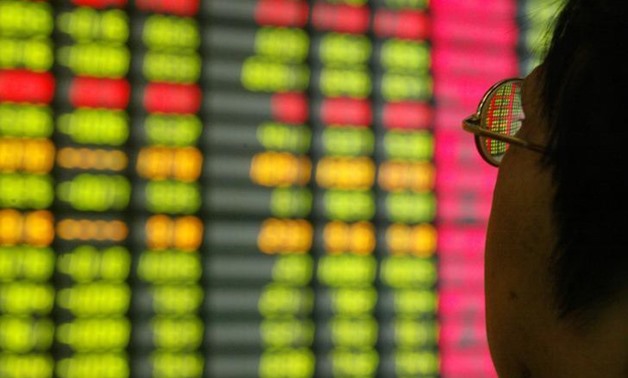
A Chinese investor monitors share prices at a securities company in Shanghai November 12, 2003. REUTERS/Claro Cortes IV/File Photo
TOKYO - 27 November 2017: Asian stocks surrendered early modest gains and retreated from a decade high on Monday, weighed by weakness in the Chinese and South Korean markets, while the euro reached a two-month top against the dollar.
Spreadbetters expected Asia’s equity weakness would spill over into Europe, forecasting Britain’s FTSE, Germany’s DAX and France’s CAC to each open about 0.1 percent lower.
MSCI’s broadest index of Asia-Pacific shares outside Japan rose early in the session on Friday’s Wall Street gains, but was last down 0.9 percent.
The index rose to its highest since 2007 on Thursday as equity markets have enjoyed strong support this year thanks to corporate earnings rising on the back of an improving global economy.
Shanghai shares were down 0.9 percent, reaching a three-month low.
Chinese shares were already on a shaky footing after last week, hurt by a rout in the domestic bond market and fresh moves to reduce risks in the asset management industry that may bring a sea change for banks. [.SS]
South Korea’s KOSPI fell 1.4 percent as tech shares slumped following an analyst’s report suggesting the memory chip “super cycle” would soon fade, led lower by Samsung Electronics. [.KS]
Strength in tech shares pushed the S&P 500 and Nasdaq to record highs on Friday but observers noted that demand for tech-related products such as semiconductors could eventually slacken.
Japan’s Nikkei pared earlier gains and fell 0.3 percent with chip makers suffering losses. [.T]
“Global sales of semiconductors expanded greatly in the third quarter. But demand could slow in the fourth quarter as a reaction to this sharp increase, and there are warning signs such as reversals in price trends,” wrote Yoshimasa Maruyama, chief market economist at SMBC Nikko Securities in Tokyo.
In currencies, the euro was little changed at $1.1926 after nudging up to $1.1946 earlier, its highest since Sept. 22.
The common currency rode on momentum from Friday after data showed German business confidence hit a record high in November, a sign the European Union’s largest economy is on track for a boom.
The euro was also helped by Germany’s Social Democrats’ agreement on Friday to hold talks with Chancellor Angela Merkel on renewing their outgoing coalition government.
Political uncertainty in Germany stemming from Merkel’s apparent failure to form a governing coalition talks knocked the euro early last week.
The euro’s strength kept the dollar’s index against six major rivals at 92.805, not far from a two-month low of 92.675 plumbed on Friday.
The dollar lost 0.1 percent to 111.415 yen.
The Australian dollar dipped 0.2 percent to $0.7605 after rising nearly 0.75 percent the previous week.
The New Zealand dollar rose 0.2 percent to $0.6861, recovering some of Friday’s losses.
“Commodity and emerging market currencies are likely to remain firm if persisting dollar weakness supports global commodity prices,” said Junichi Ishikawa, senior forex strategist at IG Securities in Tokyo.
U.S. crude lost a bit of steam and was last down 26 cents at $58.69 per barrel, while Brent crude slipped 3 cents to $63.83.
U.S. crude oil futures rose to a 2-1/2-year high of $59.05 per barrel on Friday. A continued shutdown of a U.S.-Canada pipeline triggered supply concerns, while the prospect of OPEC extending production cuts when the group meets this week also boded well for oil. [O/R]
Copper on London Metal Exchange hit a one-month high of $7,024 a tonne amid signs of resilience in China’s industrial sector that suggested a slowly cooling, but still healthy, appetite for metals. [MET/L]
China’s industrial profits rose 25.1 percent year-on-year in October, compared with a 27.27 percent jump in September, buoyed largely by higher commodity prices.
Despite the modest slowdown, October’s growth rate was still the second-highest for a single month this year.


Comments
Leave a Comment